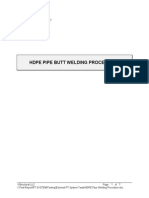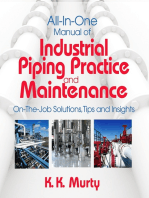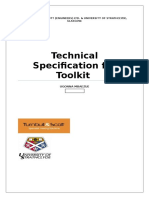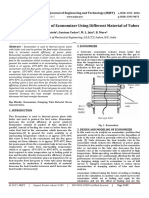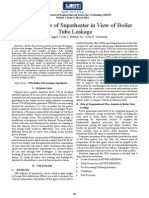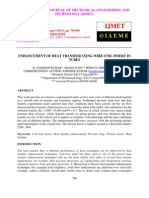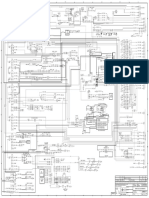Reducing Major Defects in Radiators Manufacturing: Kumar P., Sonawane B.S., Sontakke R.R., Surves.B., Wasnik A.R
Reducing Major Defects in Radiators Manufacturing: Kumar P., Sonawane B.S., Sontakke R.R., Surves.B., Wasnik A.R
Uploaded by
KrushnaCopyright:
Available Formats
Reducing Major Defects in Radiators Manufacturing: Kumar P., Sonawane B.S., Sontakke R.R., Surves.B., Wasnik A.R
Reducing Major Defects in Radiators Manufacturing: Kumar P., Sonawane B.S., Sontakke R.R., Surves.B., Wasnik A.R
Uploaded by
KrushnaOriginal Description:
Original Title
Copyright
Available Formats
Share this document
Did you find this document useful?
Is this content inappropriate?
Copyright:
Available Formats
Reducing Major Defects in Radiators Manufacturing: Kumar P., Sonawane B.S., Sontakke R.R., Surves.B., Wasnik A.R
Reducing Major Defects in Radiators Manufacturing: Kumar P., Sonawane B.S., Sontakke R.R., Surves.B., Wasnik A.R
Uploaded by
KrushnaCopyright:
Available Formats
IJSART - Volume 2
Issue 3 MARCH 2016
ISSN [ONLINE]: 2395-1052
Reducing Major defects in Radiators Manufacturing
Kumar P.1,Sonawane B.S.2,Sontakke R.R.3, SurveS.B.4,Wasnik A.R.5
1, 2, 3, 4, 5
Department of Mechanical Engineering
1, 2, 3, 4, 5
Sinhgad Institute of Technology, Lonavala, Maharashtra-410401, India.
Abstract-Radiators are heat exchangers used to transfer
thermal energy from one medium to another for the purpose of
cooling and heating. While manufacturing many defects
occurs .The aim of this paper is to apply the quality tools to
find out the root causes of the quality problems related to
manufacturing of Radiator. The modes of defects on
production line are investigated through direct observation on
the production line and statistical tools like Check sheets,
Histogram, Pareto analysis, Cause and Effect diagram are
used in enhancing the process by continuous monitoring
through inspection of the sample an always change for
betterment. The work shows utility of quality tools to find the
root causes of the problems and eliminate them.
minimizing heat loss in winter and heat gain in summer. Heat
transfer plays a major role in the design of many other
devices, such as radiators, solar collectors, various
components of power plants, and even spacecraft. One of the
important device used for heat transfer is Radiators[3].
Keywords-Radiator, Manufacturing Process, Seven QC Tools,
Fishbone Diagram,FTR Percentage.
I. INTRODUCTION
Radiators are heat exchangers used to transfer
thermal energy from one medium to another for the purpose of
cooling and heating. The radiator is always a source of heat to
its environment, although this may be for either the purpose of
heating this environment, or for cooling the fluid or coolant
supplied to it, as for engine cooling.
Radiator assembly consists of three main parts core,
inlet tank and outlet tank. Core has two sets of passage, a set
of tubes and a set of fins. Coolant flows through tubes and air
flows between fins. The hot coolant sends heat through tubes
to fins. Outside air passing between fins pickups and carries
away heat. Performance of cooling system is influenced by
factors like air and coolant mass flow rate, air inlet
temperature, coolant fluid, fin type, fin pitch, tube type and
tube pitch etc. The problems arising in the manufacture of
radiator are fin bond failure, Clinching open, internal deposit,
fin damage, cracked plastic tank, Nail tank ,Tank broken, flux
and dust on header plate, blown tank to header seal, & loose
side piece.Heat transfer is commonly encountered in
engineering systems and other aspects of life. Many ordinary
household appliances are designed, in whole or in part, by
using the principles of heat transfer. Some examples include
the electric or gas range, the heating and air-conditioning
system, the refrigerator and freezer, the water heater, the iron,
and even the computer, the TV, and the DVD player. Of
course, energy-efficient homes are designed on the basis of
Page | 44
Fig 1: Radiator Assembly
II. PRODUCTION PROCESSES OF RADIATOR
Tube mill forming-In this process small radiator tubes are
form as per requirements of radiators.
Press machining for header plate.
Fin form machine.
Radiator core assembly-In RCA assembly of header plate
fins and tube are takes place. In this process mainly H/P
tube joint defects are form.
Brazing-In brazing Flux on H/P, adherence NG defects
are form.
Clinching-In clinching Tank Broken and nail cut form.
Air/Water leak testing.
Fig. 2: Production Line Diagram
www.ijsart.com
IJSART - Volume 2
Issue 3 MARCH 2016
III. MAJOR DEFECT OCCURS IN RADIATOR
A. Tube Radiator Leakage:Radiator leakage is the defects occur during brazing
between fins and header plate.
ISSN [ONLINE]: 2395-1052
conducted research it is investigated possibilities of successful
application of 7QC tools in several companies in power
generating and process industry as well as government,
tourism and health services. The seven analyzed quality tools
are:
Flow chart
Cause-and-Effect diagram
Check sheet
Pareto diagram
Histogram
Scatter plot
Control charts
Furthermore, as a part of the research is analysis of
possibilities of systematic use of quality tools in process
industry, what is show in this paper on simple example.
Fig. 3: Radiator leakage
V. FISHBONE DIAGRAM
B. Flux on header plate: The flux was applied on substrate by dipping, and
then dried with blowing warm air. An improper amount of
flux can produced brazing joint with high porosity and flux
residue, therefore appropriate flux must be given.
Fig. 4: Flux on H/P
Fig. 5: Fishbone Diagram for Radiator leakage
C. Clinching open:These defects occur due to improper fixing between
header plate nails and radiator tank.
IV. SEVEN QUALITY TOOLS
Continuous quality improvement process assumes,
and even demands that team of experts in field as well as
company leadership actively use quality tools in their
improvement activities and decision making process. Quality
tools can be used in all phases of production process, from the
beginning of product development up to product marketing
and customer support. At the moment there are a significant
number of quality assurance and quality management tools on
disposal to quality experts and managers, so the selection of
most appropriated one is not always an easy task. In the
Page | 45
Fig.6: Fishbone Diagram of Flux on H/P
www.ijsart.com
IJSART - Volume 2
Issue 3 MARCH 2016
ISSN [ONLINE]: 2395-1052
commonly referred to as CAB (Controlled Atmosphere
Brazing). Priority to brazing the cores must be cleaned and
fluxed. The most common way to apply the flux is to mix the
flux with water and spray it onto the core. A flux machine
typically has multiple zones including a spray application
zone, and dryer section.Tube forming is the process of
forming the flat sheet metals into rectangular cross sectioned
tubes, this tube forming will be performed in tube mill
machine and According to a preferred embodiment the header
is formed in a single sheet of metal by an in expensive
stamping operation[8].
Brazing-
Fig.7:Fishbone dig. for clinching open
VI.SOLUTION FORPROBLEMS ENCOUNTERED IN
DIFFERENT PARAMETERS
A. Radiator Leakage:The big problem in radiator is the leakage to
minimize this we have to focus specially on H/P and tube joint
in brazing process.In this work an attempt is made to find out
the temp-displacement analysis of a radiator tubeelement
from temp. range 35C- 620C of a Brazing process to prevent
the leakage as it start from brazing area temperature and just
before the melting point of material as around 650C, which is
the major problem facing in the heat exchanger at header and
tube joints. A temp-displacement analysis is carried out to find
out the temperature and thermal expansion of radiator tubes
(consider 5different tube dimensions).
Brazing is a metal-joining process whereby a filler
metal is heated above melting point and distributed between
two or more close- fitting parts by capillary action. The filler
metal is brought slightly above its melting temperature while
protected by a suitable atmosphere, usually a flux. It is similar
to soldering, except the temperatures used to melt the filler
metal are higher. According to before analysis, the perfect
brazing gap for header joints and tubes is 0.03 to 0.08 mm.or it
should not be greater than 0.08 mm.In this project we are
concentrating on the leakage occurring between radiator
header and tube joint. If the gap between the header and tube
joint was perfectly made than there wont be any leakage
between header and tube. The perfect gap required between
header and tube is 0.03mm to 0.08. This is the good brazing
gap required. If the gap is 0.03 to 0.08mm between the header
and tube joint will get the perfect brazed together.
Fig.9:Gap size location
Material and Properties-
Fig.8:Tube Dimension
Aluminium radiator cores are brazed in a furnace to
join the tubes, fin, and headers. This brazing process is
Page | 46
For doing this analysis we chosen the properties of A3003
material are listed below:
Thermal conductivity = 237 w/mk
Density = 2700 kg/m3
Poisons ratio = 0.35
Coefficient of thermal expansion = 0.000023 (m/moC)
Then with the help of formulation the change in length can be
calculated aswww.ijsart.com
IJSART - Volume 2
Issue 3 MARCH 2016
dl = L0 (t1 - t0)
For dim.1.83mmdl=1.83*0.001*0.000023*(620-35)=0.02mm.
Above expansion length is same for all the dimension
approximately. In this analysis process we are finding
expansion of the based on the temperature variation from 35c
to 620 c.Thats why we selected the module tempdisplacement study state. Which helps out to find the
expansion of the tube based on the temperature varies from
35c to 620 c.By analysing the tube cross section with 5
different iterations we got the perfect tube size is 1.89 to
1.95mm.Co efficient of thermal expansion = 0.000025 /m k
In this analysis process we are finding expansion based on the
temperature variation from 35c to 620 c. also depend on
inserting dimension. This perfect tube dimension forms good
joint with header slot when the tolerances are minimum
(1.97mm) or maximum (2.07mm).
ISSN [ONLINE]: 2395-1052
From above analysis acceptable tube size is at no. 3,4
and 5 so we can conclude from above analysis,one we can
directly make tube size from above 1.89mm as its major axis,
also can make jig in range of 1.89 to 1.95mm for to reduce
cycle time or second make expansion tool for expansion for
range from lower value of tube size to between 1.89 1.95mm for brazing gap 0.03-0.08mm..so we can use this
tubes for brazing operation to avoid leakage of radiator and
mainly to reduce rejection percentage which direcly affect the
cost.Below table shows approximately analysis of rejection
and cycle time how it has affect that showed but in the ratio
and by considering anyone model of radiator.So by above
analysis we can make revision of tube tolerance limit as
approximately 1.920.03mmto reduce leakage in radiator or
can make expansion tool as for range 1.89-1.95mm.
Table 2:-Analysis of Rejection and Manufacturing Cycle-time
By using iteration i.e trial method, on the 5 different
dimensions we found out the perfect tube size which makes
perfect joint with the header slot. The analysed tolerance
results were listed below:Dimension 1.83 mmWhen we consider the minimum tolerance (1.97mm) of the
header slot dimension, then the gap/ side coming 0.06mm, and
this is the good brazing gap/side for the particular material
(A3003). When we consider the maximum tolerance
(2.07mm) of the header slot dimension, then the gap/ side
coming 0.11 mm, and this gap was beyond the good brazing
gap/side for the particular material (A3003).
Table 1:-Analysis of Tube Dimension
VII.CONCLUSION
In this paper we studies all the process for
manufacturing of a radiator and the problems in their
manufacturing process specially radiator leakageandimproved
them by qualitative and trial i.e iteration method asconsidering
perfect brazing gap from 0.03 to 0.08mm between the header
and tube joint.From that we have setted new tolerance limit as
1.920.03mm.So as defect in radiator decrease, rejection rate
also reduced and also the cycle time.
ACKNOWLEDGMENT
It is our privilege to acknowledge with deep sense of
gratitude to our Project Stage-I guide, Prof. A.R. Wasnikfor
their valuable suggestions and guidance throughout our course
of study and timely help given to us in the completion of
Project Stage-I.
Were highly obliged to Dr. V.V. Shinde, Head of
Department, Dr. M. S. Gaikwad, Principal, Sinhgad Institute
of Technology,and entire staff of Mechanical Engineering
department for their kind cooperation and help. We also take
this opportunity to thankTATA TOYO RADIATOR
LTD.and
our
guideMr.ManishsinghS.Dixit,Operation
Manager,TATA
Toyo
Radiator
Page | 47
www.ijsart.com
IJSART - Volume 2
Issue 3 MARCH 2016
Ltd.,Mr.AmitkumarC.Mehta,Mr.ArifJ.Shaikhwho backed our
interest by giving suggestions and all possible help.
ISSN [ONLINE]: 2395-1052
[11] Hea X.,.Zhanga Y., Cun H., Vibration Measurements
of Clinched Joints Procedia CIRP 26 ( 2015 ) ,pp 208
211.
REFERENCES
[1]
ShabtayY.L.,Ainali M., Lea A., New brazing processes
using anneal-resistant copper and brass alloys,
Materials and Design 25 (2004) , 14 (2004), pp 8389.
[2]
W. Fu W. , Song X.G. , Hu S.P., Chai J.H. , Brazing
copper and alumina metallized with Ti-containing
Sn0.3Ag0.7 Cu metal powder, Materials and Design ,
87 (2015) , pp 579585 .
[3]
Prof.G.Paliska,Prof.D.Palvetic,Quality tools systematic
use in process industryJournal of achievement in
materials and manufacturing industry,pp 101-110.
[4]
Oliet C., Oliva A., Castro J., Parametric studies on
automotive radiators , Applied Thermal Engineering, 27
(2007) ,pp. 20332043.
[5]
Qina G., Leib Z., Sua Y., Fua B., Large spot laser
assisted GMA brazingfusion welding of aluminumalloy
to galvanized steel, Journal of Materials Processing
Technology , 214 (2014) ,pp. 26842692.
[6]
Hasap A., Noraphaiphipaks N. , Kanchanomai C.,
Torsional strength and failure of copper alloy brazing
joint, Engineering Failure Analysis, 48 (2015),pp. 174
184.
[7]
Taheri-Garavand A., Ahmadi H., An intelligent
approach for cooling radiator fault diagnosis based on
infrared thermal image processing technique, Applied
Thermal Engineering ,87 (2015) ,pp. 434-443 .
[8]
Prof.A.MunniapanDesign Modification and analysis of
header tube joint in heat exchangerInternational journal
of innovative research in science, engineering,pp.100115.
[9]
Glembin1 J., Bttner C., , Thermal Storage Tanks in
High Efficiency Heat Pump Systems Optimized
Installation and Operation Parameters Energy Procedia
,73 ( 2015 ) pp 331 340.
[12] Prof..Solanki J.,Prof.Acharya H. Optimization of
Defects in Encountered
manufacturing of
radiatorInternational journal of advance engineering
and Resesarch Development ,scientific journal of impact
factor, pp 134-139.
[13] Myhren J., Holmberg S., Improving the thermal
performance of ventilation radiators : The role of internal
convection fins International Journal of Thermal
Sciences ,50 (2011) , pp 115-123 .
[10] Wang, C.,.Kam H., Cheong W. Effect of tool
eccentricity on the joint strength in mechanical clinching
process ProcediaEngineering , 81 ( 2014 ) ,pp 2062
2067.
Page | 48
www.ijsart.com
You might also like
- Air Cooled Heat Exchanger Handbook: Fundamentals, Calculations, Design and Q&AFrom EverandAir Cooled Heat Exchanger Handbook: Fundamentals, Calculations, Design and Q&ANo ratings yet
- Westfalia Testing Repair ElectricalDocument1,049 pagesWestfalia Testing Repair ElectricalPaweł Korobajło100% (1)
- HDPE Welding ProcedureDocument7 pagesHDPE Welding ProcedureRaden Armanadi100% (4)
- All-in-One Manual of Industrial Piping Practice and MaintenanceFrom EverandAll-in-One Manual of Industrial Piping Practice and MaintenanceRating: 5 out of 5 stars5/5 (1)
- (N) Chapter 6 Open Drain MsmaDocument57 pages(N) Chapter 6 Open Drain MsmaIr Fik TNo ratings yet
- Failure Analysis of Tube and Shell Heat ExchangerDocument5 pagesFailure Analysis of Tube and Shell Heat ExchangerIJRASETPublicationsNo ratings yet
- Flow Analysis of Gas Turbine Blade For Optimum CoolingDocument8 pagesFlow Analysis of Gas Turbine Blade For Optimum CoolingijsretNo ratings yet
- Heat Exchanger Failure CourseworkDocument4 pagesHeat Exchanger Failure Courseworkswqoqnjbf100% (2)
- 30 Ncmer037Document16 pages30 Ncmer037Arslan ArshadNo ratings yet
- Heat TransferDocument9 pagesHeat TransferAjinkya MoreNo ratings yet
- Enhancing The Heat-Transfer Co-Efficient by Using Taguchi Orthogonal ArrayDocument4 pagesEnhancing The Heat-Transfer Co-Efficient by Using Taguchi Orthogonal ArrayinventionjournalsNo ratings yet
- An Overview of The Automated Pouring ProcessDocument9 pagesAn Overview of The Automated Pouring ProcesskarthikkandaNo ratings yet
- Heat Sink Capacity Mesurment in Inservice PipelineDocument13 pagesHeat Sink Capacity Mesurment in Inservice PipelineSomeshNo ratings yet
- New Microsoft Word Document 4.1Document19 pagesNew Microsoft Word Document 4.1prashantmaukaNo ratings yet
- Presssure Die-CastingDocument12 pagesPresssure Die-CastingritaNo ratings yet
- Design Optimization of Hot Forming Tools by Numerical Thermal AnalysisDocument18 pagesDesign Optimization of Hot Forming Tools by Numerical Thermal AnalysisvishalNo ratings yet
- 5.david - .Spencer - Air Cooled HE TTSDocument6 pages5.david - .Spencer - Air Cooled HE TTSBaher ElsheikhNo ratings yet
- Review Paper On Investigation of Perfomance For Shell and Tube Heat Exchanger - 45688Document5 pagesReview Paper On Investigation of Perfomance For Shell and Tube Heat Exchanger - 45688lvmengke1994No ratings yet
- Sunny Manohar 2018 IOP Conf. Ser. Mater. Sci. Eng. 455 012132 PDFDocument10 pagesSunny Manohar 2018 IOP Conf. Ser. Mater. Sci. Eng. 455 012132 PDFParitosh ParasharNo ratings yet
- CFD Analysis Towards Optimizing The Parameters of Vortex TubeDocument7 pagesCFD Analysis Towards Optimizing The Parameters of Vortex TubeLalitha LalliNo ratings yet
- Ijert Ijert: Failure Investigation of Secondary Super Heater Using CFD/CAE TechniqueDocument5 pagesIjert Ijert: Failure Investigation of Secondary Super Heater Using CFD/CAE TechniqueJeferson MarceloNo ratings yet
- Experimental Analysis of Advanced Materials For Anticorrosive Heat ExchangerDocument6 pagesExperimental Analysis of Advanced Materials For Anticorrosive Heat ExchangerAnonymous MVHQ97KEoPNo ratings yet
- Experimental and Comparison Study of Heat Transfer Characteristics of Wickless Heat Pipes by Using Various Heat InputsDocument12 pagesExperimental and Comparison Study of Heat Transfer Characteristics of Wickless Heat Pipes by Using Various Heat InputsIJRASETPublicationsNo ratings yet
- Experiment On Thermal Conductivity of Oil-1Document15 pagesExperiment On Thermal Conductivity of Oil-1Raj DoshiNo ratings yet
- Thermal Specification SheetDocument12 pagesThermal Specification SheetUgonna100% (1)
- Thermal Analysis of Shell and Tube Heat ExchangerDocument6 pagesThermal Analysis of Shell and Tube Heat ExchangerInternational Journal of Research in Engineering and TechnologyNo ratings yet
- Performance Analysis of Economizer Using Journal 4Document3 pagesPerformance Analysis of Economizer Using Journal 4adventius S.SNo ratings yet
- 9 Strip Casting Technology PYMenetDocument5 pages9 Strip Casting Technology PYMenetNikolas Kolasni Lakenir Ckerde DockosNo ratings yet
- A CFD Based Analysis of Solar Air Heater Having V-Shaped Perforated Blocks On Absorber PlateDocument8 pagesA CFD Based Analysis of Solar Air Heater Having V-Shaped Perforated Blocks On Absorber PlateAshok Singh YadavNo ratings yet
- Inspection of Double Tube Sheet Exch - Presentation1Document37 pagesInspection of Double Tube Sheet Exch - Presentation1Jignesh Pandya100% (1)
- Design and Fabrication of Shell and Tube Heat Exchanger: April 2017Document6 pagesDesign and Fabrication of Shell and Tube Heat Exchanger: April 2017castanares12335No ratings yet
- Design and Analysis of Hot Runner Nozzle-2046Document14 pagesDesign and Analysis of Hot Runner Nozzle-2046ValterSantosNo ratings yet
- IRJET Experimental Investigations of Double Pipe Heat Exchanger With Triangular Baffles PDFDocument5 pagesIRJET Experimental Investigations of Double Pipe Heat Exchanger With Triangular Baffles PDFRidhoQodriNo ratings yet
- TMP 296 EDocument14 pagesTMP 296 EFrontiersNo ratings yet
- CFD Analysis in A Heat Sink For Cooling Of-LibreDocument11 pagesCFD Analysis in A Heat Sink For Cooling Of-LibreVedant DubeyNo ratings yet
- Shell & Tube HEDocument6 pagesShell & Tube HEvinodNo ratings yet
- Design and Fabrication of Thermoforming Machine For Production of Disposable Thermoplastic TraysDocument6 pagesDesign and Fabrication of Thermoforming Machine For Production of Disposable Thermoplastic TraysALAZAR MICHAELNo ratings yet
- CFD Analysis of Superheater in View of Boiler Tube Leakage: Ajay N. Ingale, Vivek C. Pathade, Dr. Vivek H. TatwawadiDocument3 pagesCFD Analysis of Superheater in View of Boiler Tube Leakage: Ajay N. Ingale, Vivek C. Pathade, Dr. Vivek H. Tatwawadidinesh23cbeNo ratings yet
- Titanium Tube Failures-Power PlantsDocument11 pagesTitanium Tube Failures-Power PlantsgshdavidNo ratings yet
- Lifetime Assessment of A Steam Pipeline: 1 2 Material 15 128 (14MOV6-3)Document6 pagesLifetime Assessment of A Steam Pipeline: 1 2 Material 15 128 (14MOV6-3)Costas Aggelidis100% (1)
- Heat Pipe SelectionDocument6 pagesHeat Pipe SelectionSridhar RaoNo ratings yet
- Rethink Specifications For Fired HeatersDocument7 pagesRethink Specifications For Fired HeatersAhmed SeliemNo ratings yet
- Heat Pipe PHD ThesisDocument6 pagesHeat Pipe PHD Thesismichelledavisvirginiabeach100% (1)
- Temperature Induced Dimensional Variation in Extrusion: Articles You May Be Interested inDocument8 pagesTemperature Induced Dimensional Variation in Extrusion: Articles You May Be Interested inAliraza AlirazaNo ratings yet
- 16trans IIM-2010 PDFDocument4 pages16trans IIM-2010 PDFRajaSekarNo ratings yet
- An Investigation On Tube Temperature Distribution in A Water Tube BoilerDocument6 pagesAn Investigation On Tube Temperature Distribution in A Water Tube BoilerKelvinWongNo ratings yet
- Luciano Mantovano, Marcos Ponciano, Santiago Serebrinsky, Hugo Ernst, Teresa Pérez, Martin Valdez, Luis ChadDocument10 pagesLuciano Mantovano, Marcos Ponciano, Santiago Serebrinsky, Hugo Ernst, Teresa Pérez, Martin Valdez, Luis ChadMarcelo Varejão CasarinNo ratings yet
- Improve The Efficiency of Heat Exchanger in Oil CoolerDocument29 pagesImprove The Efficiency of Heat Exchanger in Oil CoolerMuhammad RustamNo ratings yet
- A Comparative Study of Heat Energy Dissipated From Electronic Devices by CFD AnalysisDocument5 pagesA Comparative Study of Heat Energy Dissipated From Electronic Devices by CFD AnalysisManoj KumarNo ratings yet
- Enhancement of Heat Transfer Using Wire Coil Insert in TubesDocument10 pagesEnhancement of Heat Transfer Using Wire Coil Insert in TubesIAEME PublicationNo ratings yet
- Nanotechnology Integrated Automobile Radiator: SciencedirectDocument5 pagesNanotechnology Integrated Automobile Radiator: SciencedirectShreyas NairNo ratings yet
- A Complete Analysis of Your Reformer-SynetixDocument9 pagesA Complete Analysis of Your Reformer-SynetixhendraokasNo ratings yet
- Waste Heat Recovery Considering Environmental FactorsDocument7 pagesWaste Heat Recovery Considering Environmental FactorsrvnesariNo ratings yet
- Jornal Air Heater PerformanceDocument8 pagesJornal Air Heater PerformanceSu Crez No AtmajaNo ratings yet
- Chang 2016Document22 pagesChang 2016luã seixasNo ratings yet
- CFD Analysis For Cone Helically Coiled Tube Heat Exchanger by Varying Pitch Ijariie11095Document8 pagesCFD Analysis For Cone Helically Coiled Tube Heat Exchanger by Varying Pitch Ijariie11095pkvssraoNo ratings yet
- Chemical & Mechanical DesignDocument39 pagesChemical & Mechanical DesignSenah DaunNo ratings yet
- Estimator's Piping Man-hours Tool: Estimating Man-hours for Carbon Steel Process Piping Projects. Manual of Man-hours, ExamplesFrom EverandEstimator's Piping Man-hours Tool: Estimating Man-hours for Carbon Steel Process Piping Projects. Manual of Man-hours, ExamplesNo ratings yet
- Thermal Modelling of Power Transformers Using Computational Fluid DynamicsFrom EverandThermal Modelling of Power Transformers Using Computational Fluid DynamicsNo ratings yet
- Heating Systems Troubleshooting & Repair: Maintenance Tips and Forensic ObservationsFrom EverandHeating Systems Troubleshooting & Repair: Maintenance Tips and Forensic ObservationsNo ratings yet
- Sandip S Wakade PPT SeminarDocument24 pagesSandip S Wakade PPT SeminarKrushnaNo ratings yet
- Fini /clear /prep7 /title, Modal Analysis K, 1 K, 2,20,0 K, 3,20,5 K, 4,0,5 K, 5,0,0,-200 L, 1,5 A, 1,2,3,4 Vdrag, 1,,,,,,1Document1 pageFini /clear /prep7 /title, Modal Analysis K, 1 K, 2,20,0 K, 3,20,5 K, 4,0,5 K, 5,0,0,-200 L, 1,5 A, 1,2,3,4 Vdrag, 1,,,,,,1KrushnaNo ratings yet
- Publications Conf - Journals OnlyDocument18 pagesPublications Conf - Journals OnlyKrushnaNo ratings yet
- S11 Acoustic HolographyDocument10 pagesS11 Acoustic HolographyKrushnaNo ratings yet
- International Journal: Papers/Seminars Presented: List of Papers Published in The Year 2012-13-14-15Document2 pagesInternational Journal: Papers/Seminars Presented: List of Papers Published in The Year 2012-13-14-15KrushnaNo ratings yet
- Big Data Analytics As A Service For Affective Humanoid Service RobotsDocument8 pagesBig Data Analytics As A Service For Affective Humanoid Service RobotsKrushnaNo ratings yet
- Advatage SDocument9 pagesAdvatage Salishba mohsinNo ratings yet
- Aramco Engineering - Evaluating Motor SpecificationsDocument161 pagesAramco Engineering - Evaluating Motor Specificationsdeepu220100% (1)
- Revised Cyber or Digital LiteracyDocument11 pagesRevised Cyber or Digital LiteracySonia Pineda RiveraNo ratings yet
- Web Part Type IdsDocument8 pagesWeb Part Type IdsWilliam JansenNo ratings yet
- Parts Manual: CascadeDocument16 pagesParts Manual: CascadeSARAMQRNo ratings yet
- Leontief ParadoxDocument7 pagesLeontief ParadoxJungsuk KimNo ratings yet
- Budget Radio Telescope For DIYDocument14 pagesBudget Radio Telescope For DIYtawfekmNo ratings yet
- Curriculum Vitae: Key QualificationsDocument5 pagesCurriculum Vitae: Key QualificationsNESPAK Field Office SukkurNo ratings yet
- Gerunds and Infinitives, Theory & PracticeDocument11 pagesGerunds and Infinitives, Theory & Practice1907989100% (1)
- F.Y.B.M.S. 2019 - 20 Second Merit List: H.R. College of Commerce & EconomicsDocument5 pagesF.Y.B.M.S. 2019 - 20 Second Merit List: H.R. College of Commerce & EconomicsPriyanshu SharmaNo ratings yet
- AS3030 User Manual - 606-0000-681Document95 pagesAS3030 User Manual - 606-0000-681Pedro BastidasNo ratings yet
- Abha Mtech EceDocument20 pagesAbha Mtech EcePrashantyelekarNo ratings yet
- WayToEng2 UT1 Level3 AKDocument1 pageWayToEng2 UT1 Level3 AKluapomar23No ratings yet
- Glass Viper User Guide PDFDocument9 pagesGlass Viper User Guide PDFLeonardo MacielNo ratings yet
- RT 900 User GuideDocument83 pagesRT 900 User GuideRAMPrabhuNo ratings yet
- Os ReportDocument93 pagesOs ReportMinsha N PNo ratings yet
- Ca3162 ADocument7 pagesCa3162 Ajnax101No ratings yet
- SME - Metal Enclosed SwitchgearsDocument4 pagesSME - Metal Enclosed SwitchgearsViorel BorsNo ratings yet
- Lesson 03 State and Action Verbs HomeworkDocument4 pagesLesson 03 State and Action Verbs HomeworkAhmed EltohamyNo ratings yet
- Phase Failure Relay: Specification FunctionDocument1 pagePhase Failure Relay: Specification Functionsandesh sawateNo ratings yet
- Oh Ms Believer-Twenty One PilotsDocument3 pagesOh Ms Believer-Twenty One Pilotskristi maherNo ratings yet
- Easy Start Guide LS IC5Document15 pagesEasy Start Guide LS IC5Arvind KumarNo ratings yet
- NITK, Placement CellDocument14 pagesNITK, Placement CellShashi Kumar BaranwalNo ratings yet
- N - Arc Third Party Inspection Report of BPL Households Under Rggvy 12Th Plan WorksDocument21 pagesN - Arc Third Party Inspection Report of BPL Households Under Rggvy 12Th Plan WorksPrashant TrivediNo ratings yet
- Using Gridded Rainfall Products in Simulating Streamflow in A Tropical Catchment - A Case Study of The Srepok River Catchment, VietnamDocument8 pagesUsing Gridded Rainfall Products in Simulating Streamflow in A Tropical Catchment - A Case Study of The Srepok River Catchment, VietnamShankar YadavNo ratings yet
- FIN240 Questions 1Document5 pagesFIN240 Questions 1Robin HexNo ratings yet
- l8r0253s - ElectDocument6 pagesl8r0253s - ElectGILMAR NIETONo ratings yet
- Background: Project Proposal: IV Infusion Rate Controller IIDocument2 pagesBackground: Project Proposal: IV Infusion Rate Controller IIAbraham JyothimonNo ratings yet


